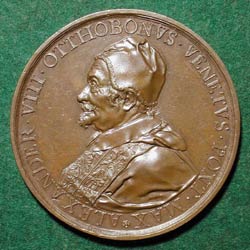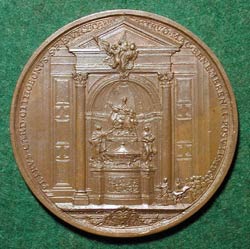

|
ALEXANDER VIII OTTOBONI MEMORIAL ST. URBAIN, Ferdinand: Papal States, 1700, Bronze, 64
mm Pietro Vito Ottoboni (Alexander VIII) (1610-1691) was born at Venice,
the son of Marco Ottoboni, chancellor of the Republic of Venice, and a
descendant of a noble family of that city. The future pope enjoyed the
wealth and social position that allowed him to pursue higher education. In
1627 he obtained a doctorate in canon and civil law from the University of
Padua. He was made Cardinal by Innocent X in 1652 and was later given the
Bishopric of Brescia, where he quietly spent the best years of middle
life. He was already an octogenarian when elected to the papacy as
Alexander VIII, and lived but sixteen months. During this brief period he
reconciled some differences with Louis XIV of France, who had been
secretly excommunicated by Ottoboni's predecessor, Pope Innocent XI, and
in response had once more taken Avignon from the pope. Now with Alexander
VIII, Louis restored Avignon to the papacy, and renounced the right of
asylum for the French Embassy. Ottoboni also assisted his native Venice by
generous subsidies in the war against the Turks, and purchased for the
Vatican library the books and manuscripts owned by Queen Christina of
Sweden. Alexander was an upright man, generous, peace-loving, and
indulgent. Out of compassion for the poor of Italy, he sought to reduce
their taxes. But this same generous nature led him to bestow on his
relations the riches they were eager to accumulate; in their behalf, and
to the discredit of his pontificate, he revived sinecure offices which had
been suppressed by his predecessor. (From the Catholic Encyclopedia). |
|